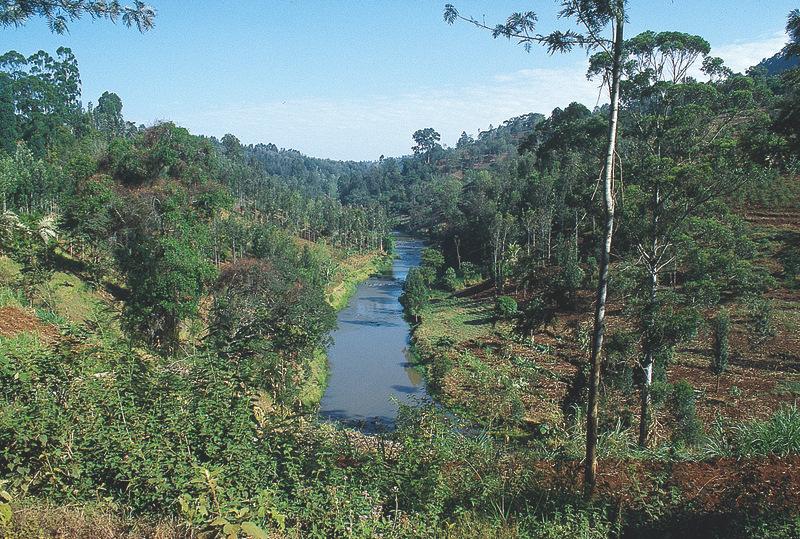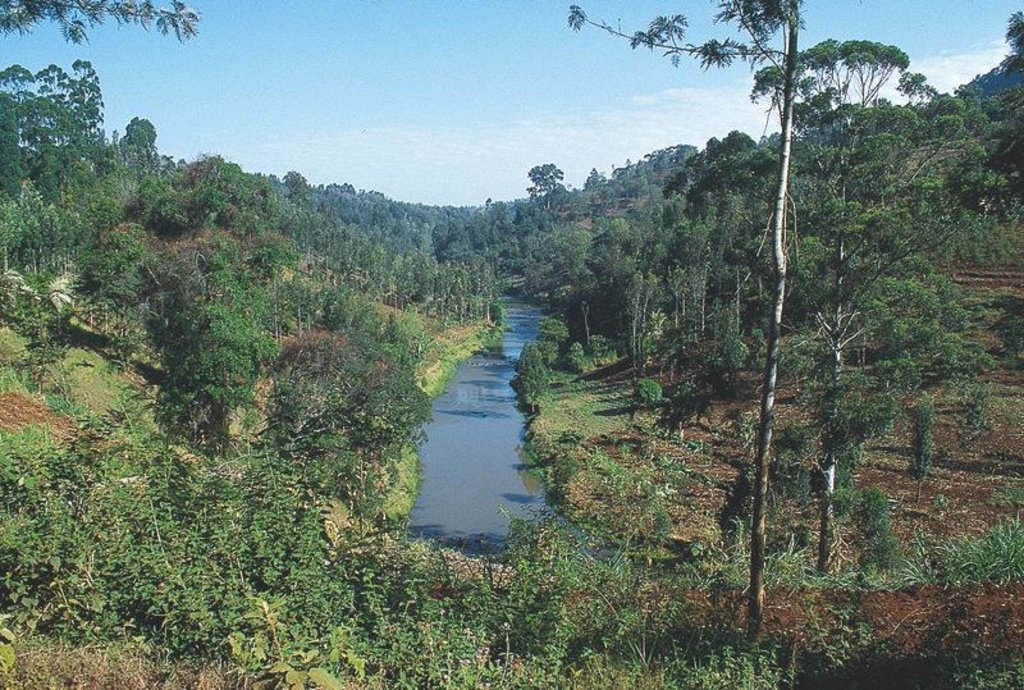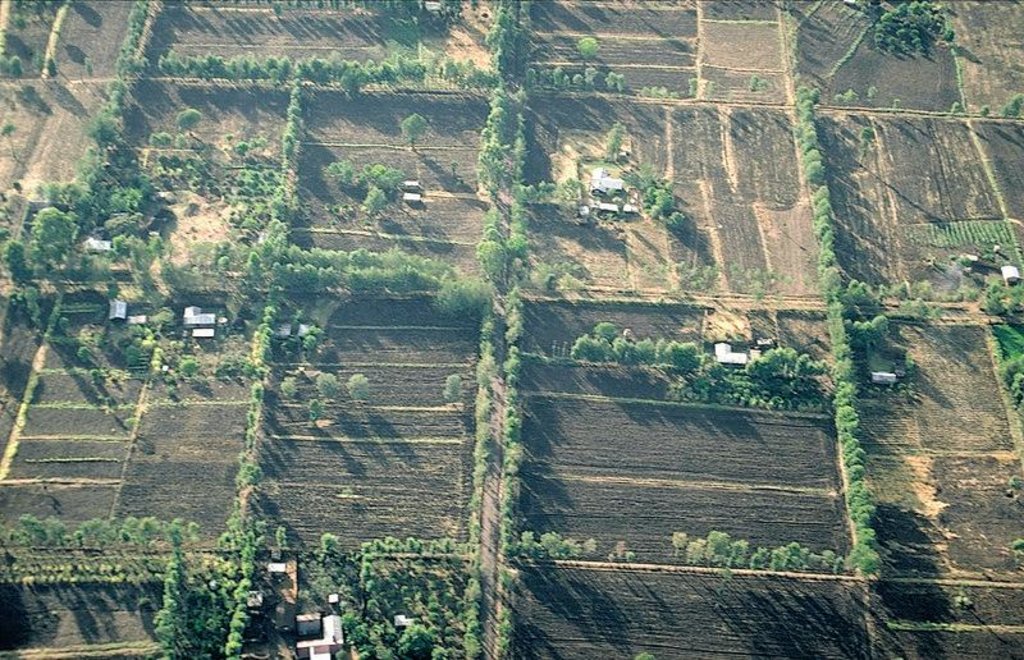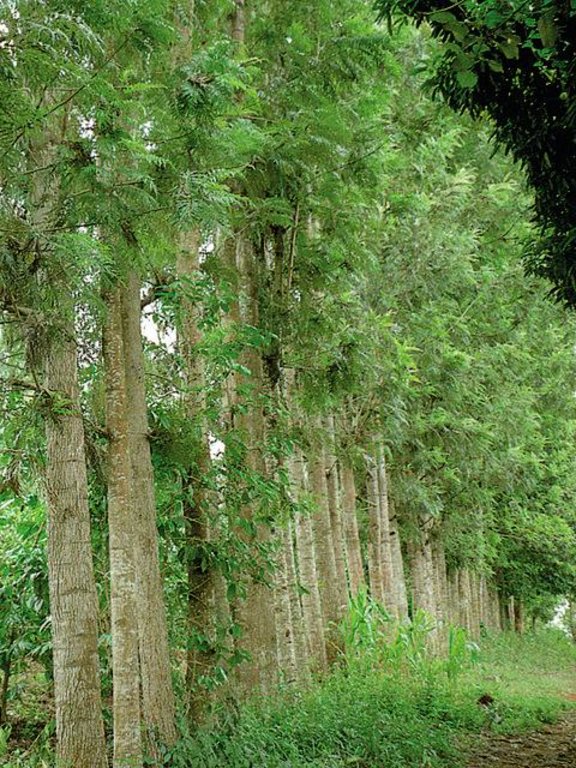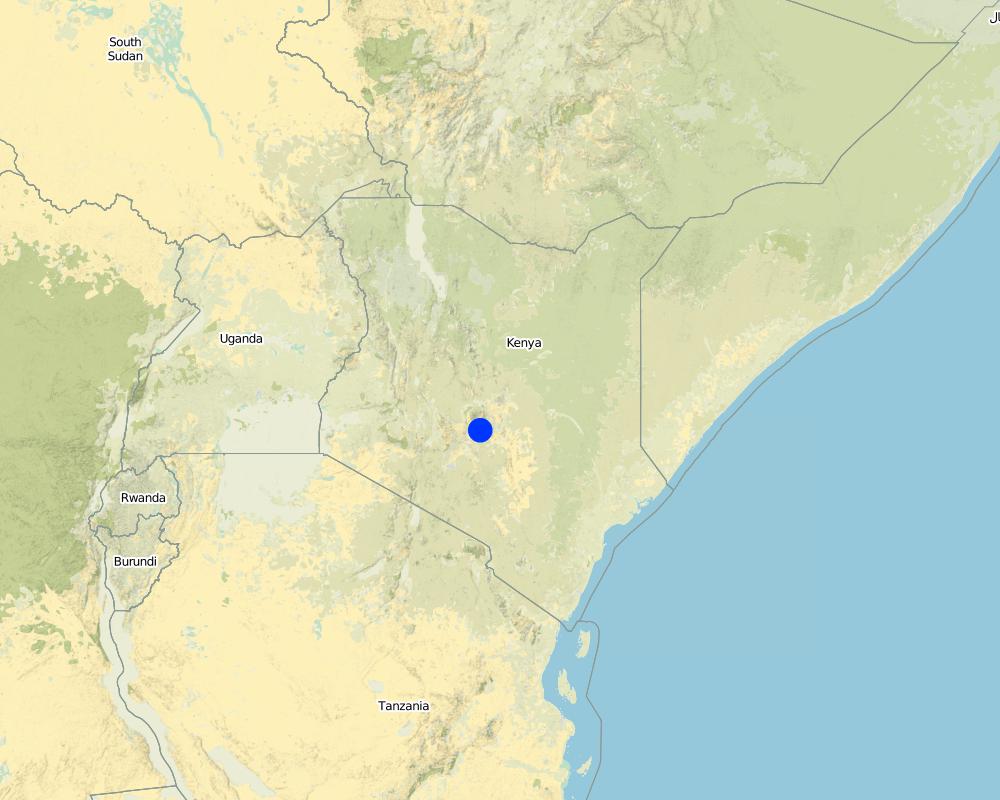Grevillea agroforestry system [Kenya]
- Creation:
- Update:
- Compiler: Ceris A. Jones
- Editor: –
- Reviewers: Deborah Niggli, David Streiff, Alexandra Gavilano
Mukima, Mubariti
technologies_1339 - Kenya
- Full summary as PDF
- Full summary as PDF for print
- Full summary in the browser
- Full summary (unformatted)
- Grevillea agroforestry system: May 5, 2017 (inactive)
- Grevillea agroforestry system: May 6, 2019 (public)
- Grevillea agroforestry system: April 4, 2018 (inactive)
- Grevillea agroforestry system: April 4, 2018 (inactive)
- Grevillea agroforestry system: March 30, 2017 (inactive)
- Grevillea agroforestry system: March 23, 2017 (inactive)
- Grevillea agroforestry system: March 22, 2017 (inactive)
View sections
Expand all Collapse all1. General information
1.2 Contact details of resource persons and institutions involved in the assessment and documentation of the Technology
State employee:
Mwaniki John Munene
Ministry of Agriculture & Rural Development
Kenya
Name of project which facilitated the documentation/ evaluation of the Technology (if relevant)
Book project: where the land is greener - Case Studies and Analysis of Soil and Water Conservation Initiatives Worldwide (where the land is greener)Name of project which facilitated the documentation/ evaluation of the Technology (if relevant)
Book project: SLM in Practice - Guidelines and Best Practices for Sub-Saharan Africa (SLM in Practice)Name of the institution(s) which facilitated the documentation/ evaluation of the Technology (if relevant)
Ministry of Agriculture, Livestock and Fisheries (MoA) - Kenya1.3 Conditions regarding the use of data documented through WOCAT
The compiler and key resource person(s) accept the conditions regarding the use of data documented through WOCAT:
Yes
1.5 Reference to Questionnaire(s) on SLM Approaches (documented using WOCAT)
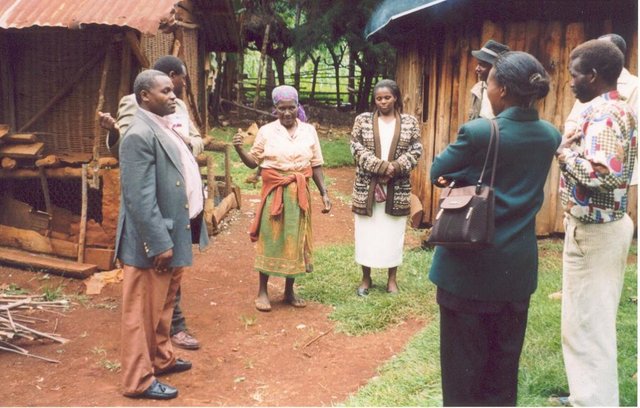
Spontaneous spread [Kenya]
Spontaneous land users' initiative to meet household needs - especially firewood and timber - through planting Grevillea robusta trees as part of an agroforestry system.
- Compiler: Ceris A. Jones
2. Description of the SLM Technology
2.1 Short description of the Technology
Definition of the Technology:
Multipurpose Grevillea robusta trees planted along farm boundaries, on terrace risers and occasionally scattered in cropland.
2.2 Detailed description of the Technology
Description:
While Grevillea robusta (the ‘silky oak’, an Australian native tree) was originally introduced from India to East Africa as a shade tree for tea and coffee estates, it is now more commonly associated with small-scale farming areas. There are three main forms of grevillea agroforestry systems: (1) most commonly trees are planted along farm boundaries, initially at a close spacing (0.75-1 m), then later thinned to 1.5-3 m, giving approximately 400 plants/ha; (2) scattered grevillea trees associated with annual or perennial crops: resembling open forests with multi-storey layers; (3) grevillea is sometimes grown in a form of ‘alley cropping’ on terraces, with 4–8 m interval between the rows and a spacing of 3-5 m within the rows.
Grevillea is primarily used in combination with annual (maize/beans) and perennial crops (coffee). It can be easily propagated and established and is relatively free of pests and diseases. Trees are managed through periodic pollarding - the pruning of side branches (for use) while maintaining the trunk. This gives the visual impression of ‘telegraph poles’, but competition with crops (which is little, in any case) is reduced and pruned branches rapidly regrow. An additional measure for avoiding competition with crops is to dig a small trench around the trees, thus cutting the superficial roots.
Grevillea is planted for a number of purposes. These include marking property boundaries, supplying fuelwood and building materials, providing shade and for ornamental value. Simultaneously it can control raindrop splash (when an understorey of litter builds up beneath), increases organic matter, and provides mulching materials to improve ground cover in the farm. Grevillea reduces wind speed, and encourages nutrient recycling due to its deep rooting.
While the climate in the case study area is subhumid, and the slopes moderate to steep with soils of medium erodibility, grevillea can be planted over a wide range of agroecological zones - from semi-arid to humid zones, and from sea level up to 2,000 metres and higher. It is ideally suited to intensive areas of small-scale mixed farming, where grevillea is valued primarily for the supply of products (fuel and construction wood in particular) to meet various household needs: it is not mainly targeted at soil erosion control though this is achieved in various ways as explained above. To effectively combat soil erosion problems on slopes, grevillea planting must be combined with additional measures such as fanya juu and bench terraces, grass strips and other vegetative and agronomic forms of conservation.
2.3 Photos of the Technology
2.5 Country/ region/ locations where the Technology has been applied and which are covered by this assessment
Country:
Kenya
Region/ State/ Province:
Kiawanja catchment, Nembure division, Embu,
Specify the spread of the Technology:
- evenly spread over an area
If the Technology is evenly spread over an area, specify area covered (in km2):
0.015
If precise area is not known, indicate approximate area covered:
- < 0.1 km2 (10 ha)
Comments:
Total area covered by the SLM Technology is 1.5 km2.
Map
×2.6 Date of implementation
If precise year is not known, indicate approximate date:
- more than 50 years ago (traditional)
2.7 Introduction of the Technology
Specify how the Technology was introduced:
- as part of a traditional system (> 50 years)
Comments (type of project, etc.):
Trees initially sourced from nurseries
3. Classification of the SLM Technology
3.1 Main purpose(s) of the Technology
- reduce, prevent, restore land degradation
3.2 Current land use type(s) where the Technology is applied
Land use mixed within the same land unit:
Yes
Specify mixed land use (crops/ grazing/ trees):
- Agroforestry

Cropland
- Annual cropping
- Perennial (non-woody) cropping
- Tree and shrub cropping
Annual cropping - Specify crops:
- cereals - maize
- legumes and pulses - beans
Perennial (non-woody) cropping - Specify crops:
- banana/plantain/abaca
Tree and shrub cropping - Specify crops:
- coffee, shade grown
- tree nuts (brazil nuts, pistachio, walnuts, almonds, etc.)
Number of growing seasons per year:
- 2
Specify:
Longest growing period in days: 120 Longest growing period from month to month: Mar - Jun Second longest growing period in days: 120 Second longest growing period from month to month: Oct - Jan

Forest/ woodlands
- Tree plantation, afforestation
Type of tree:
- Grevillea robusta
Products and services:
- Timber
Comments:
Main products/ services: grevillea trees, maize/beans, coffee, macadamia and banana
Major land use problems (compiler’s opinion): - land degradation, mainly by water erosion
- soil fertility decline due to continuous cropping and few inputs
- lack of fuelwood, building materials, and other tree related products
Major land use problems (land users’ perception): Soil fertility decline
Type of cropping system and major crops comments: After land preparation, maize is planted followed by the legumes (mainly beans), depending on the rainfall regime
3.4 Water supply
Water supply for the land on which the Technology is applied:
- rainfed
3.5 SLM group to which the Technology belongs
- agroforestry
- improved ground/ vegetation cover
- improved plant varieties/ animal breeds
3.6 SLM measures comprising the Technology

vegetative measures
- V1: Tree and shrub cover
Comments:
Main measures: vegetative measures
Secondary measures: structural measures
Type of vegetative measures: scattered / dispersed
3.7 Main types of land degradation addressed by the Technology

soil erosion by water
- Wt: loss of topsoil/ surface erosion

chemical soil deterioration
- Cn: fertility decline and reduced organic matter content (not caused by erosion)

water degradation
- Ha: aridification
Comments:
Main type of degradation addressed: Wt: loss of topsoil / surface erosion, Cn: fertility decline and reduced organic matter content, Ha: aridification
Main causes of degradation: deforestation / removal of natural vegetation (incl. forest fires) (Common access to resources (communal land ownership))
Secondary causes of degradation: over-exploitation of vegetation for domestic use (Increased population pressure on land), other human induced causes (specify) (Agricultural causes - Opening up of more agricultural land), land tenure (Before land registration, land users were reluctant to undertake long term investment)
3.8 Prevention, reduction, or restoration of land degradation
Specify the goal of the Technology with regard to land degradation:
- reduce land degradation
Comments:
Main goals: mitigation / reduction of land degradation
4. Technical specifications, implementation activities, inputs, and costs
4.1 Technical drawing of the Technology
Technical specifications (related to technical drawing):
Grevillea tree are most commonly planted along field or farm boundary - but also around houses. Spacing of trees is initially dense; later they are thinned. Other options (not shown here) are scattered planting in association with annual/ perennial crops, or in rows along terraces.
Technical knowledge required for field staff / advisors: moderate
Technical knowledge required for land users: low
Main technical functions: increase in organic matter, reduction in wind speed, improvement of ground cover (mainly leaf mulch from pruning), plant nutrient recycling due to deep rooting
Secondary technical functions: control of raindrop splash, increase of infiltration, improvement of soil structure
Scattered / dispersed
Vegetative material: T : trees / shrubs
Spacing between rows / strips / blocks (m): 4-8
Width within rows / strips / blocks (m): 3-5
Vegetative measure: along farm boundaries
Vegetative material: T : trees / shrubs
Number of plants per (ha): 400
Width within rows / strips / blocks (m): 1.5-3
Vegetative measure: 'alley croppin' on terraces
Vegetative material: T : trees / shrubs
Vegetative measure: Vegetative material: T : trees / shrubs
Vegetative measure: Vegetative material: T : trees / shrubs
Trees/ shrubs species: Grevillea robusta seedlings
Author:
Mats Gurtner
4.2 General information regarding the calculation of inputs and costs
Specify currency used for cost calculations:
- USD
other/ national currency (specify):
Kenya shilling
Indicate average wage cost of hired labour per day:
1.30
4.3 Establishment activities
| Activity | Timing (season) | |
|---|---|---|
| 1. | Dig planting pits | before rainy seasons |
| 2. | Purchase seedlings from nurseries/collection of wildings | Onset of the rains |
| 3. | Transplant | Onset of the rains |
4.4 Costs and inputs needed for establishment
| Specify input | Unit | Quantity | Costs per Unit | Total costs per input | % of costs borne by land users | |
|---|---|---|---|---|---|---|
| Labour | Digging holes | ha | 1.0 | 25.0 | 25.0 | 100.0 |
| Equipment | Tools | ha | 1.0 | 10.0 | 10.0 | 100.0 |
| Plant material | Seedlings | ha | 1.0 | 125.0 | 125.0 | 100.0 |
| Total costs for establishment of the Technology | 160.0 | |||||
| Total costs for establishment of the Technology in USD | 160.0 | |||||
Comments:
Duration of establishment phase: 24 month(s)
4.5 Maintenance/ recurrent activities
| Activity | Timing/ frequency | |
|---|---|---|
| 1. | Weeding around seedlings when necessary | rainy season /when necessary |
| 2. | Pruning as necessary (pruned branches are dried and used for | Dry season /annual |
| 3. | Pollarding (pruning of side branches; ensures large and straight | Dry season /annual, after crop harvest |
| 4. | Root pruning: dig a trench (60 cm from tree, 25 cm deep) and cut | |
| 5. | Felling some trees to reduce density as they grow bigger | Dry season /when necessary |
| 6. | Replanting if/when trees are harvested for timber. | Onset of rain /when necessary |
4.6 Costs and inputs needed for maintenance/ recurrent activities (per year)
| Specify input | Unit | Quantity | Costs per Unit | Total costs per input | % of costs borne by land users | |
|---|---|---|---|---|---|---|
| Labour | Weeding, prunning etc. | ha | 1.0 | 65.0 | 65.0 | 100.0 |
| Equipment | Tools | ha | 1.0 | 25.0 | 25.0 | 100.0 |
| Total costs for maintenance of the Technology | 90.0 | |||||
| Total costs for maintenance of the Technology in USD | 90.0 | |||||
Comments:
Basis of costing: boundary planting (assuming average plot size of 25 m x 25 m (0.16 ha) and an average spacing of 1 m between trees = 1,000 trees/ha. 1 person plants 50 trees in one day. The labour required for management (pruning and pollarding) of established trees is high. Seedling purchase price is also high, but this can be reduced by collecting ‘wildings’ (seedlings growing in the wild) as well as establishment of personal or group nurseries.
4.7 Most important factors affecting the costs
Describe the most determinate factors affecting the costs:
high labour demand for nagement (pruning and pollarding) of established trees. Seedling purchase price is also high and increases as demand rises.
5. Natural and human environment
5.1 Climate
Annual rainfall
- < 250 mm
- 251-500 mm
- 501-750 mm
- 751-1,000 mm
- 1,001-1,500 mm
- 1,501-2,000 mm
- 2,001-3,000 mm
- 3,001-4,000 mm
- > 4,000 mm
Specify average annual rainfall (if known), in mm:
1200.00
Agro-climatic zone
- sub-humid
Thermal climate class: tropics
5.2 Topography
Slopes on average:
- flat (0-2%)
- gentle (3-5%)
- moderate (6-10%)
- rolling (11-15%)
- hilly (16-30%)
- steep (31-60%)
- very steep (>60%)
Landforms:
- plateau/plains
- ridges
- mountain slopes
- hill slopes
- footslopes
- valley floors
Altitudinal zone:
- 0-100 m a.s.l.
- 101-500 m a.s.l.
- 501-1,000 m a.s.l.
- 1,001-1,500 m a.s.l.
- 1,501-2,000 m a.s.l.
- 2,001-2,500 m a.s.l.
- 2,501-3,000 m a.s.l.
- 3,001-4,000 m a.s.l.
- > 4,000 m a.s.l.
Comments and further specifications on topography:
Landforms: Also footslopes and valley floors
Slopes on average: Also moderate and steep
5.3 Soils
Soil depth on average:
- very shallow (0-20 cm)
- shallow (21-50 cm)
- moderately deep (51-80 cm)
- deep (81-120 cm)
- very deep (> 120 cm)
Soil texture (topsoil):
- medium (loamy, silty)
Topsoil organic matter:
- medium (1-3%)
- low (<1%)
If available, attach full soil description or specify the available information, e.g. soil type, soil PH/ acidity, Cation Exchange Capacity, nitrogen, salinity etc.
Soil depth on average: Also moderately deep
Soil fertility is very low - medium and soils are exhausted due to continous cropping and few inputs. Soil erosion is also a big threat.
Topsoil organic matter is low - medium because crop residues rarely left to allow fertility to build-up. Some manure added but generally insufficient.
Soil drainage / infiltration is good because of the slopy and deep well drained nitosols
Soil water storage capacity is low - high
5.6 Characteristics of land users applying the Technology
Market orientation of production system:
- mixed (subsistence/ commercial)
Off-farm income:
- less than 10% of all income
Relative level of wealth:
- average
Individuals or groups:
- individual/ household
Level of mechanization:
- manual work
Indicate other relevant characteristics of the land users:
Population density: > 500 persons/km2
Annual population growth: 2% - 3%
5% of the land users are rich and own 3% of the land.
60% of the land users are average wealthy and own 80% of the land.
30% of the land users are poor and own 15% of the land.
5% of the land users are poor and own 2% of the land.
Off-farm income specification: Few land users have off farm employment.
Market orientation of production system: Coffee, macadamia nuts, grevillea timber, and milk
5.7 Average area of land used by land users applying the Technology
- < 0.5 ha
- 0.5-1 ha
- 1-2 ha
- 2-5 ha
- 5-15 ha
- 15-50 ha
- 50-100 ha
- 100-500 ha
- 500-1,000 ha
- 1,000-10,000 ha
- > 10,000 ha
Is this considered small-, medium- or large-scale (referring to local context)?
- small-scale
Comments:
Average area of land owned or leased by land users applying the Technology: Also < 0.5 ha
5.8 Land ownership, land use rights, and water use rights
Land ownership:
- individual, titled
Land use rights:
- individual
6. Impacts and concluding statements
6.1 On-site impacts the Technology has shown
Socio-economic impacts
Production
crop production
Comments/ specify:
through mulching and nutrient pumping
fodder production
Comments/ specify:
leaves provide limited fodder during dry periods
wood production
Comments/ specify:
for timber and fuelwood
production area
Comments/ specify:
occupies part of cropland – but compensated by tree products
Income and costs
farm income
workload
Comments/ specify:
labour for tree establishment and maintenance can conflict with other activities
Socio-cultural impacts
SLM/ land degradation knowledge
Comments/ specify:
interaction with other – boundary conflicts (potential for shading neighbours' crops)
conflict mitigation
Comments/ specify:
potential for shading neighbours' crops
housing
Comments/ specify:
more timber available
Ecological impacts
Water cycle/ runoff
surface runoff
Quantity before SLM:
40
Quantity after SLM:
35
Soil
soil moisture
Comments/ specify:
encouraging infiltration through mulching
soil cover
Comments/ specify:
mulch and canopy cover
soil loss
Quantity before SLM:
5
Quantity after SLM:
4
nutrient cycling/ recharge
Biodiversity: vegetation, animals
invasive alien species
Comments/ specify:
growing reliance on single exotic, replacing other local tree species
animal diversity
Comments/ specify:
bees, birds, etc.
Climate and disaster risk reduction
wind velocity
Comments/ specify:
windbreaks for crops and homesteads
Other ecological impacts
Soil fertility
Comments/ specify:
leaf litter and nutrient recycling
mulch and canopy cover
6.2 Off-site impacts the Technology has shown
reliable and stable stream flows in dry season
downstream flooding
Comments/ specify:
infiltration encouraged
downstream siltation
Comments/ specify:
reduced soil erosion
groundwater/ river pollution
Comments/ specify:
reduced sediment load in the streams
Deforestation
Comments/ specify:
alternative source of fuel and timber
Creation of employment
Comments/ specify:
through tree management and harvesting
6.3 Exposure and sensitivity of the Technology to gradual climate change and climate-related extremes/ disasters (as perceived by land users)
Gradual climate change
Gradual climate change
| Season | increase or decrease | How does the Technology cope with it? | |
|---|---|---|---|
| annual temperature | increase | well |
Climate-related extremes (disasters)
Meteorological disasters
| How does the Technology cope with it? | |
|---|---|
| local rainstorm | well |
| local windstorm | not known |
Climatological disasters
| How does the Technology cope with it? | |
|---|---|
| drought | well |
Hydrological disasters
| How does the Technology cope with it? | |
|---|---|
| general (river) flood | not known |
Comments:
High tolerance to temperature changes and rainfall, Grevillea grows in a wide variety of climates
6.4 Cost-benefit analysis
How do the benefits compare with the establishment costs (from land users’ perspective)?
Short-term returns:
slightly positive
Long-term returns:
very positive
How do the benefits compare with the maintenance/ recurrent costs (from land users' perspective)?
Short-term returns:
slightly positive
Long-term returns:
very positive
6.5 Adoption of the Technology
- 11-50%
If available, quantify (no. of households and/ or area covered):
120 household in an area of 1.5 sq km (>500 persons/sq km)
Of all those who have adopted the Technology, how many did so spontaneously, i.e. without receiving any material incentives/ payments?
- 91-100%
Comments:
100% of land user families have adopted the Technology without any external material support
120 land user families have adopted the Technology without any external material support
Comments on spontaneous adoption: survey results
There is no trend towards spontaneous adoption of the Technology
Comments on adoption trend: 100% of land users have adopted the technology, but harvested trees are immediately replaced.
6.7 Strengths/ advantages/ opportunities of the Technology
| Strengths/ advantages/ opportunities in the land user’s view |
|---|
| Reduction of runoff and raindrop strength |
| Strengths/ advantages/ opportunities in the compiler’s or other key resource person’s view |
|---|
|
Multipurpose tree, meeting various socio-economic needs: provision of fuelwood (for household energy needs) and timber, boundary marking, ornamental function; leaves provide fodder during severe drought How can they be sustained / enhanced? Selfsustaining (no action needed). |
|
Ease of propagation with minimal technical skill How can they be sustained / enhanced? Self-sustaining (no action needed). |
|
Income generation opportunities (eg selling tree products) How can they be sustained / enhanced? Improvement in rural access roads to facilitate transport of tree products and other farm produce to market; encourage diversification: eg furniture making. |
| Microclimate improvement. |
|
Crop yields are boosted by the tree nutrient recycling, fallen leaves add organic matter on decomposition. Reduction of runoff and hence soil erosion can be significant. The tree canopy associated with an understorey of litter reduces raindrop impact while the roots hold soil in place. |
6.8 Weaknesses/ disadvantages/ risks of the Technology and ways of overcoming them
| Weaknesses/ disadvantages/ risks in the land user’s view | How can they be overcome? |
|---|---|
| On the slopes, the effectiveness of agroforestry is limited, in the fight against soil erosion | Combine with agronomic and vegetative measures (contour plowing, mulching, grass strips) and if necessary with structural measures (terraces, bunds and ditches) |
| Weaknesses/ disadvantages/ risks in the compiler’s or other key resource person’s view | How can they be overcome? |
|---|---|
| Seedlings and wildings not always readily available | Encourage local seed collection and setting up of group tree nurseries. |
| Timber susceptibility to pests attack |
Timber treatment with appropriate chemicals; breeding of more pest tolerant varieties – particularly against weevils. |
| Livestock sometimes damage the young seedlings | Protection by fencing. |
| Dry periods result in low seedling survival rates: planting not possible in dry areas | With water harvesting and moisture management techniques, the technology could spread to lower rainfall areas. |
| Cultural conflicts | Trim the branches of the trunk regularly; Dig a small trench around the trees to cut the superficial roots |
7. References and links
7.2 References to available publications
Title, author, year, ISBN:
ICRAF. 1992. A selection of useful trees and shrubs in Kenya. ICRAF, Nairobi
Title, author, year, ISBN:
Guto et al. 1998. PRA report, Kiawanja catchment, Nembure division, Embu District-Kenya. Ministry of Agriculture, Nembure division, Embu
Title, author, year, ISBN:
Harwood CE. 1989. Grevillea robusta: an annotated bibliography: ICRAF, Nairobi
7.3 Links to relevant online information
Title/ description:
Rocheleau D., F. Weber and A .Field-Juma. 1988. Agroforestry in dryland Africa: ICRAF, Nairobi
URL:
http://www.ces.uga.edu/pubcd/b949-w.html , http://www.winrock.org/forestry/factpub/factsh/grevillea.html
Links and modules
Expand all Collapse allLinks

Spontaneous spread [Kenya]
Spontaneous land users' initiative to meet household needs - especially firewood and timber - through planting Grevillea robusta trees as part of an agroforestry system.
- Compiler: Ceris A. Jones
Modules
No modules


